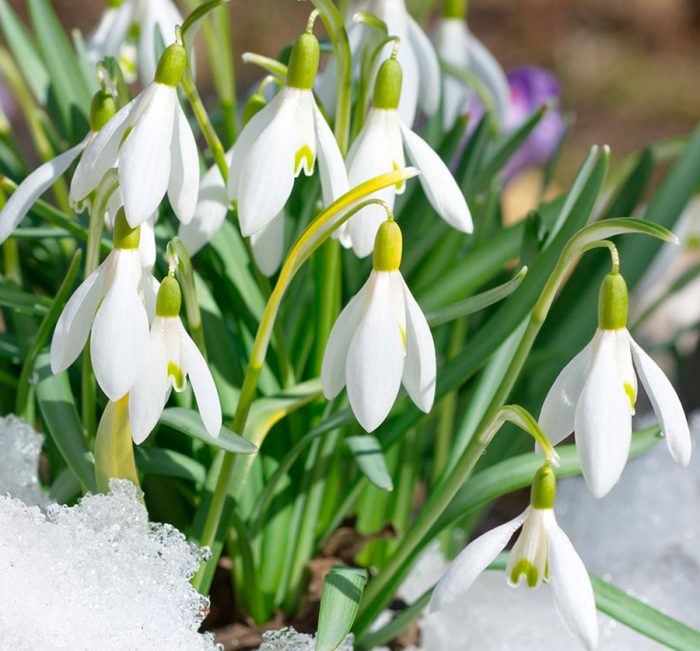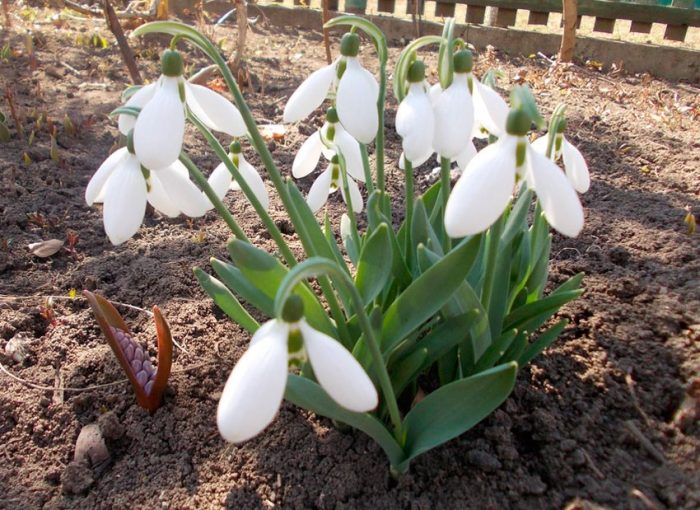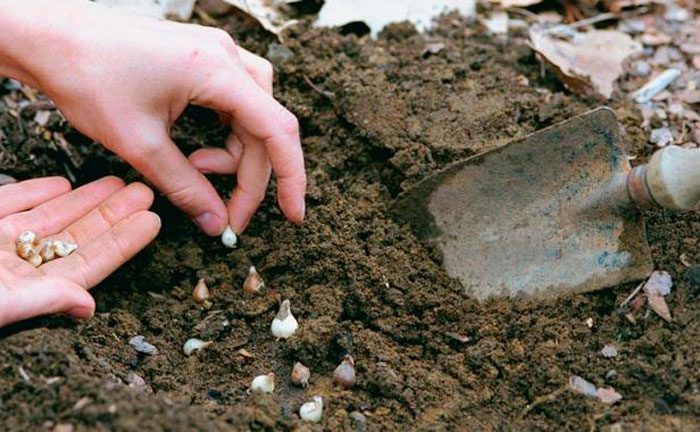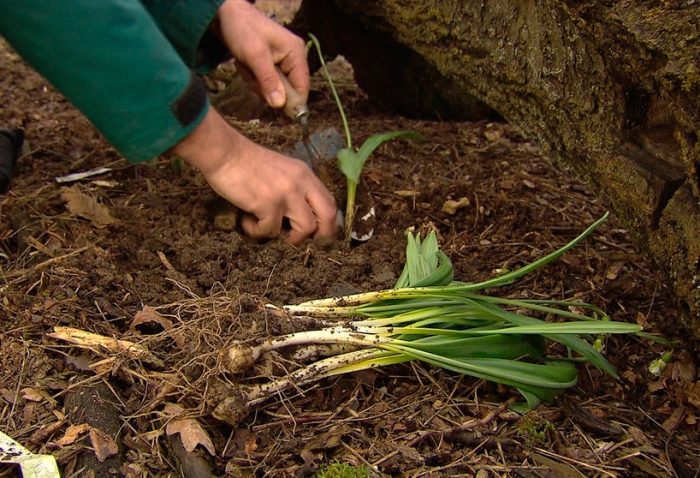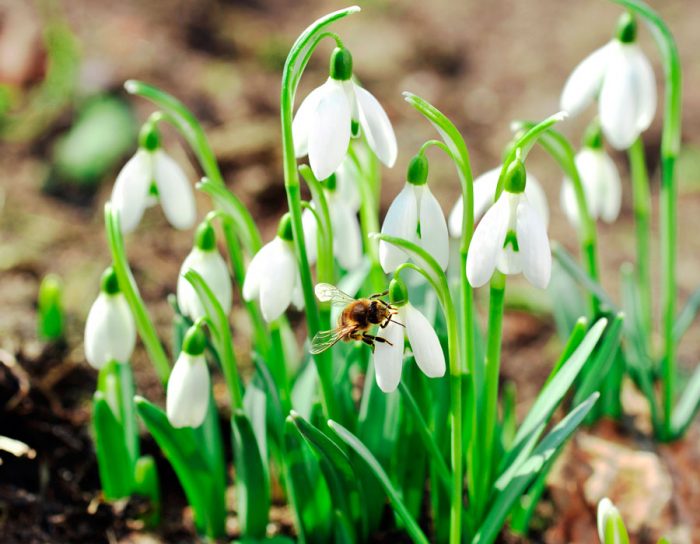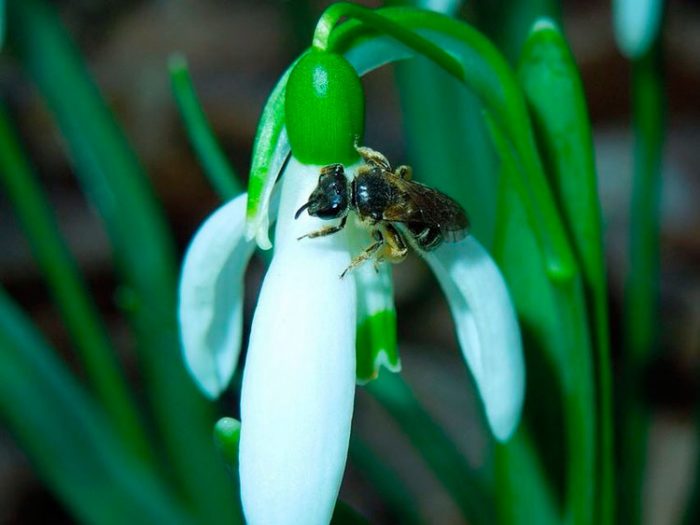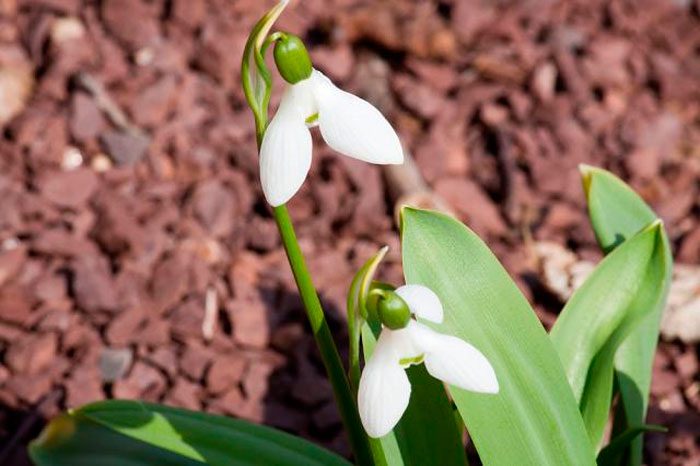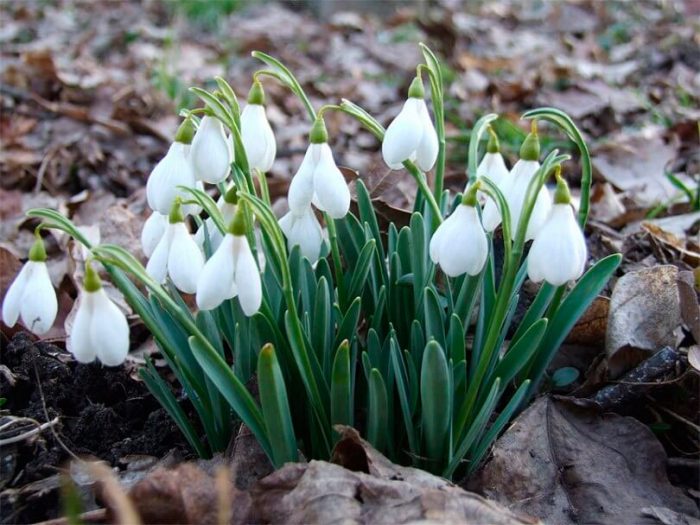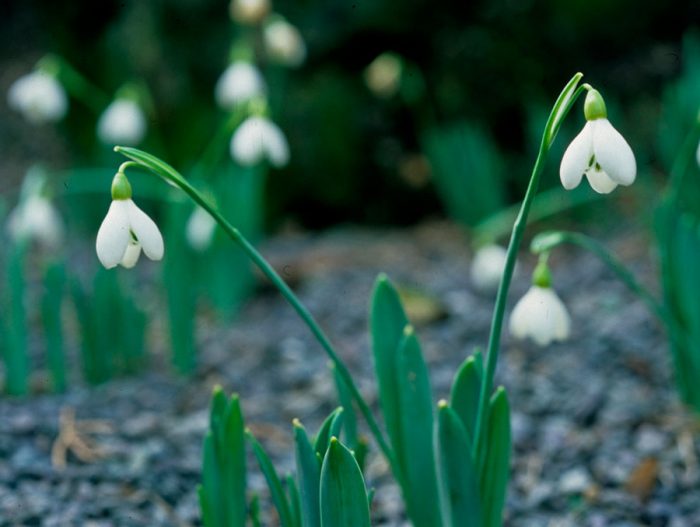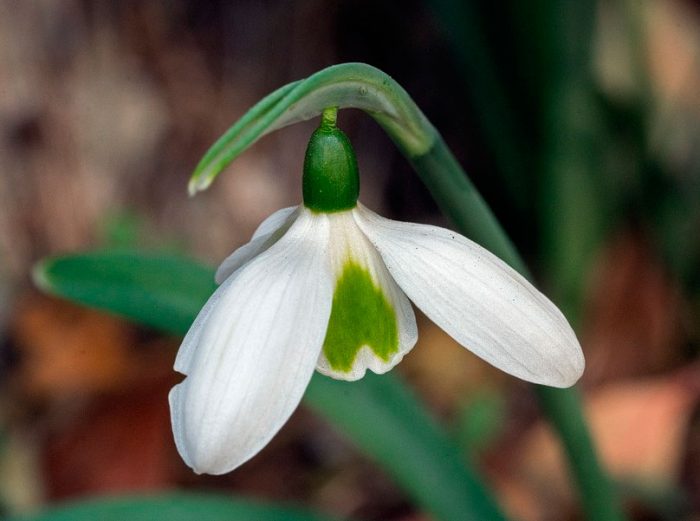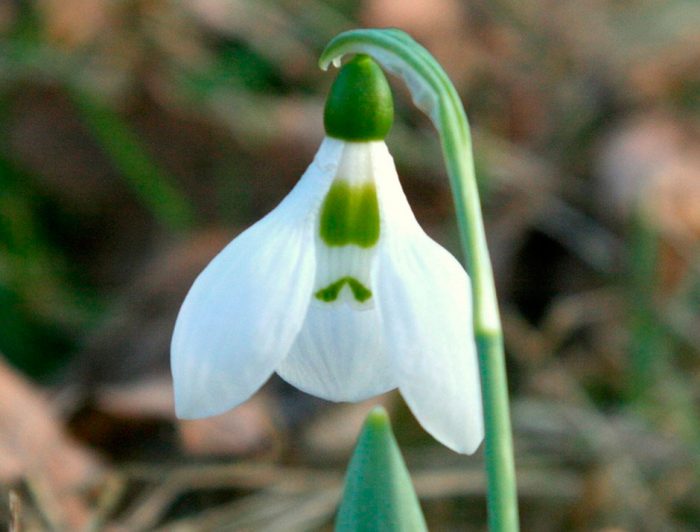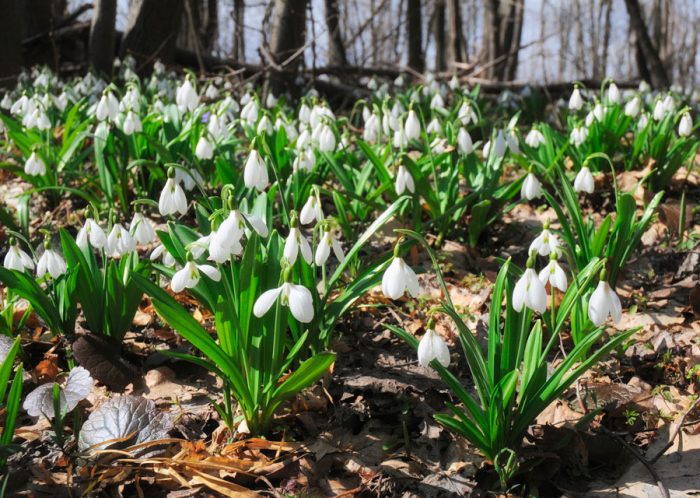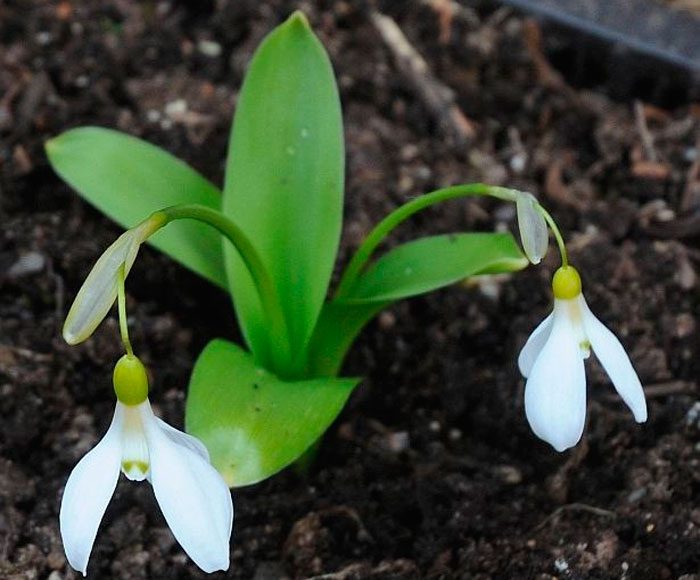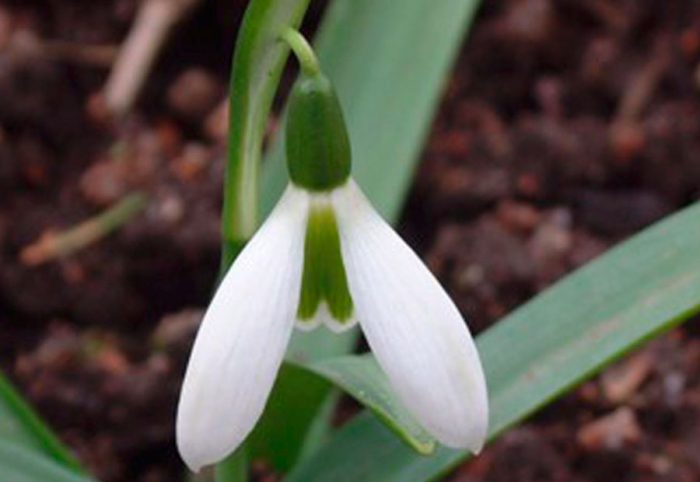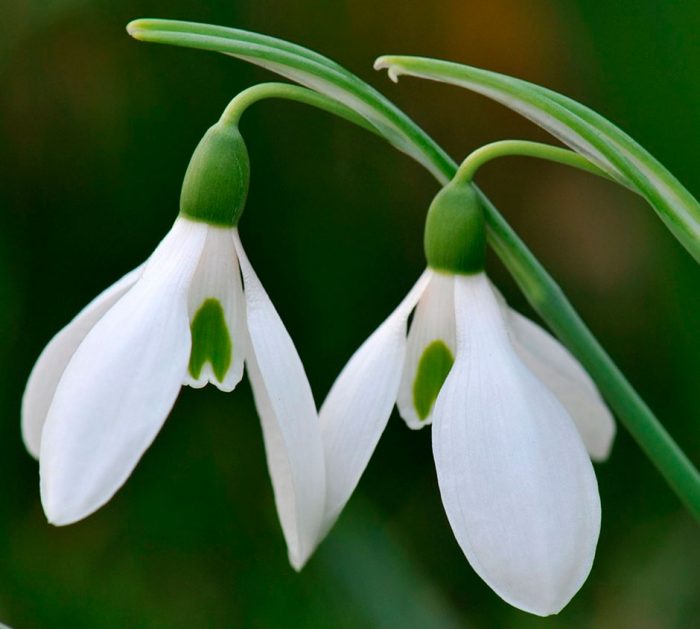The herbaceous perennial plant, the snowdrop (Galanthus), also called galanthus, is a member of the Amaryllidaceae family. This genus unites 18 species and a couple of natural hybrids. The scientific name of this plant, translated from ancient Greek, means "milky-flowered", which is associated with the color of the flowers. In England such a flower is called "snow drop" or "snow earring", and the Germans call it "snow bell", and in Russia its second name is "snowdrop", this is due to the fact that such flowers appear when the surface of the earth still covered with snow. In the Caucasus, the largest number of species is found, namely, 16 pieces, while 6 of these species are endangered, therefore they are listed in the Red Book. Most of the snowdrop species have long been cultivated by gardeners as ornamental plants. For example, such a terry form as Flore Pleno has been cultivated since 1731. Many beautiful legends are associated with such a plant. For example, one of them says that on the day when Eve and Adam left Eden, it snowed. Eve got very cold and began to cry, and the Creator, trying to console her, turned several snowflakes into snowdrops, which became the first flowers on Earth.
Content
- 1 Snowdrop features
- 2 Planting snowdrops in open ground
- 3 Caring for snowdrops in the garden
- 4 Snowdrop pests and diseases
- 5 Types and varieties of snowdrops with photos and names
- 5.1 Alpine snowdrop (Galanthus alpinus = Galanthus schaoricus)
- 5.2 Caucasian snowdrop (Galanthus caucasicus)
- 5.3 Bortkewich's snowdrop (Galanthus bortkewitschianus)
- 5.4 Cilician snowdrop (Galanthus cilicicus = Galanthus rizehensis)
- 5.5 Elvis Snowdrop (Galanthus elwesii)
- 5.6 Folded snowdrop (Galanthus plicatus)
- 5.7 Broadleaf snowdrop (Galanthus platyphyllus = Galanthus latifolius)
- 5.8 Snowdrop Ikarian (Galanthus ikariae)
- 5.9 Snowdrop snowdrop (Galanthus nivalis)
Snowdrop features
Snowdrop is a perennial bulbous plant. Their growing season is very short, while its duration depends on the climatic characteristics of the region where such a flower grows. The bulbs reach from 20 to 30 mm in diameter, and they include scales that are 1-3 years old. Every year, 3 scales grow on the bulb, while babies form in their sinuses. Folded or smooth, matte or shiny leaf plates are keeled on the underside. Foliage and flowers appear at the same time. The foliage is colored in various shades of green. In cross-section, the flower arrow can be rounded or slightly flattened.It can be gray or glossy, and the arrow ends with a bracts and a drooping flower. When the flowering is almost over, the flower arrow will become hollow. The bracts include a pair of bracts. The perianth consists of 6 leaves, namely, three outer ones, painted pure white, and the same number of inner ones - on their white surface there is a speck of green color formed by strokes, it is located very close to the apex. Flowering is observed in the first half of the spring. Flowers need insects for pollination. The fruit is a fleshy opening box with spherical seeds inside.
Planting snowdrops in open ground
What time to plant
Experienced gardeners recommend purchasing and planting snowdrop bulbs in open soil in July – September. If the autumn period is long and warm, then the bulbs can be planted until November. It is not recommended to buy bulbs with opened flowers, because after planting in open ground they will dry out and die off. However, the bulb will not die off, but next season the flowering of such a bush will be very weak, and in some cases it does not bloom at all. It is recommended to choose bulbs that are heavy and dense, while the protective shells must be intact. It is also better if the planting material does not show signs of the beginning of growth (rudiments of peduncles or roots), otherwise it will need to be planted in open soil immediately after purchase. There may be cuts on the bulb, but be careful not to injure the scales. Broken or crumpled planting material is not worth buying, since there is a high probability that the crushed and crushed areas will begin to rot. Purchased bulbs should not be stored for more than 4 weeks. However, if you have to store the planting material longer, then it is recommended to place it in a perforated plastic bag, while the bulbs must be sprinkled with sawdust or shavings.
Landing rules
For planting spring galanthuses, you should choose open sunny areas, but they can also be grown in a shaded place under shrubs or trees. Wet, loose and well-drained soil is best suited for growing these flowers. Areas with clay and heavy soil, as well as those where there is stagnation of liquid, are not suitable for planting snowdrops. Such flowers have the ability to regulate the depth of planting, so if they are planted too deeply, then a new bulb will form on the peduncle of the bush at the depth that it needs. If the bulbs are planted at a shallow depth, they will gradually shrink, but they will begin to grow intensively with children. Galanthuses should be planted in the ground to a depth of at least 50 mm. The most spectacular plantings of snowdrops, consisting of 10-30 bushes.
Caring for snowdrops in the garden
It is very easy to grow galanthuses in your garden. Watering such a culture is not needed, since in the spring, after the snow cover has melted, the soil contains a fairly large amount of liquid. However, if in winter there was very little snow, and in spring there is a drought, then at times it is necessary to water the bushes, otherwise they will be low. This plant also does not need weeding, since during the active growth of the snowdrop there are no weeds yet.
It is necessary to feed such a plant regularly, but certain rules must be followed. It is not necessary to apply fertilizers to the soil, which contain a large amount of nitrogen, this element contributes to the rapid growth of green mass, but if there is a lot of foliage, then at low temperature and high humidity there is a high probability of developing a fungal disease.For feeding such a plant, a complex mineral fertilizer is ideal, which should contain a large amount of phosphorus and potassium. The fact is that potassium helps the bush to form healthy and strong bulbs that are highly winter-hardy. And phosphorus helps to stimulate galanthus flowering.
Transfer
It is possible to grow such a culture in the same place for a long time, however, experts advise transplanting once every 5-6 years. This is because in 1 year about 2 babies are formed on the bulb, and within 6 years quite a lot of them grow, and they begin to feel a lack of nutrients. In this regard, the bulbs should be regularly dug up, divided and planted.
Reproduction of snowdrops
Transplant and divide the bush into parts, while the foliage of the snowdrop has not yet completely wilted and dried up. It is necessary to separate the bulbs, uncleaned from the soil residues. After the cuts have been processed with crushed coal, the bulbs are immediately planted in the holes in a permanent place.
A snowdrop can also be grown from seeds, while it must be borne in mind that such a culture reproduces well and self-sowing. The first flowering of plants grown from seeds will come only 4 or 5 years after the appearance of seedlings.
After flowering
When the bushes fade, the foliage is not cut off immediately, but only after it dies off on its own, otherwise the bulb recovery process will be disrupted, and the bush may not bloom next season. And the foliage also contributes to the accumulation of nutrients by the bulbs, thanks to which they can normally survive the winter in the soil. When planting bulbs in autumn in late autumn, the surface of the site should be covered with humus or peat.


Watch this video on YouTube
Snowdrop pests and diseases
Diseases
Galanthus, when grown in the garden, can infect a viral or fungal disease. On the aerial part of the plant affected by a viral disease, marks and streaks of a pale yellow or greenish color are formed, the texture of the leaf plate acquires tuberosity, and the edge of the foliage is wrapped. The affected bush must be dug up and destroyed as soon as possible, while the area where it was grown should be spilled with a strong solution of potassium manganese.
If streaks of brown or black color are formed on the foliage, then this indicates that the plant is affected by rust. If it is sick with gray rot, then a fluffy bloom of gray color forms on its surface. Parts of the plant affected by the disease must be cut out and destroyed, while the bushes themselves and the surface of the soil near them must be sprayed with a fungicide solution, which is prepared strictly according to the instructions attached to the drug.
Spots of yellow color may also appear on the foliage, this may be due to the fact that the plant is affected by chlorosis due to a lack of iron in the soil or poor drainage. To cure a snowdrop, iron in a chelated form should be added to the soil.
Pests
On such a culture, nematodes, as well as caterpillars of butterflies, can settle. The caterpillars of the scoop injure the snowdrop bulbs; they are collected and destroyed in the autumn along with weeding. At this time, the caterpillars are preparing for pupation.
Getting rid of nematodes is very difficult. Nematodes are small worms, but they cannot be seen with the naked eye. In the bush on which such worms have settled, irregular tumors of a pale yellow color are formed along the edge of the leaf plates. On the cut of the bulb, a dark speck is clearly distinguishable, separating its healthy part from the diseased one. All infected bushes must be removed from the ground and burned. The bulbs of healthy plants must be dug out, the remains of the soil are removed from them, and then they are kept for 3 to 4 hours in lukewarm water (from 40 to 45 degrees). The area infested with nematodes is not used for growing any crops for at least five years.
Rodents such as mice and moles can also harm a snowdrop, they injure the bulbs in the ground, and they can carry them away to their burrow. Those areas on the bulbs that have been gnawed, as a rule, rot, the growth slows down in the bushes, and they look depressed outwardly. Damaged bulbs must be dug out and all decayed areas must be cut out to healthy tissue. Places of cuts are treated with crushed coal or wood ash, after which they wait until they dry out. In order to prevent damage to the bulbs by rodents, they should not be planted in an area with a diameter of 3 m of which there are herbaceous or perennial plants with sods that form a curtain. The fact is that mice prefer to settle in them, but the rodents do not move further than 3 m from their own nest. To get rid of moles, it is recommended to place several baits with poison or traps on the site.
Underground slugs can harm Galanthus, it should be noted that they prefer to live in fertile clay soil. To clear the soil of such pests, special preparations are used. In order to prevent, when planting a plant, the bulb in the hole is covered with river coarse sand at the top, and then the hole is filled to the top with ordinary soil.
Types and varieties of snowdrops with photos and names
It was already mentioned above that there is a description of 18 species in the scientific literature. However, today it is not completely clear to scientists where the species, form or variety are. The most popular representatives of the Galantus genus, which gardeners prefer to cultivate, will be described below.
Alpine snowdrop (Galanthus alpinus = Galanthus schaoricus)
This snowdrop is endemic to Western Transcaucasia. The bulb reaches 35 mm in length and 20 mm in diameter. On the surface of the dark green broad-lanceolate leaf plates there is a bloom of a bluish color. Peduncle height 60–90 mm. The flowers are white.
Caucasian snowdrop (Galanthus caucasicus)
In nature, such a plant is found in the forests of the middle and lower zones of the Central Transcaucasia. The length of the bluish leaf plates is about 0.3 m, they have a flat linear shape. The height of the peduncles is about 10 centimeters. Fragrant flowers of white color reach 25 mm in length and 15 mm in diameter. On the inner perianth lobes there are green spots, which are located closer to the tips of the petals. Such a snowdrop has been cultivated since 1887.
Bortkewich's snowdrop (Galanthus bortkewitschianus)
This plant is endemic to the North Caucasus, it got its name in honor of the famous forester and dendrologist V.M. Bortkevich. The length of the bulbs is 30–40 mm, while in diameter they can reach from 20 to 30 mm. Dark green leafy plates are lanceolate, and on their surface there is a bloom of a bluish color. The height of the flower arrows is about 60 mm, there are green spots on the surface of the white flowers.
Cilician snowdrop (Galanthus cilicicus = Galanthus rizehensis)
Such a plant can be found in the Batumi region, as well as in the foothills and mountains of Asia Minor. Dark green matte leaf plates have a linear shape. The length of the peduncles is about 18 centimeters. On the inner tepals, white flowers have specks of green color.
Elvis Snowdrop (Galanthus elwesii)
This plant gets its name from the well-known collector John Henry Elvis. It is found in the mountains of Asia Minor, South-Eastern Europe, in the Odessa region of Ukraine and in Moldova. The height of the flower arrows of such a tall plant reaches about 25 centimeters. Wide leaf plates are colored green-blue. Large fragrant flowers have a spherical shape. This species is variable, for example, 15 forms of such a snowdrop are grown in Europe. For example, Galanthus elwesii var. maxima: this shape has larger leaf plates than the main species, and they have a wavy edge.
Folded snowdrop (Galanthus plicatus)
In nature, such galanthus is found in the foothills of Romania, Moldova and the Crimea. In this genus, this species is considered the largest. The peculiarity of such a plant is that its folded leaf plates have an outward curved edge. As soon as flowering begins, a bluish bloom appears on the surface of the leaf plates, and at the end they become glossy dark green in color. The height of the peduncles can reach 25 centimeters. The flowers reach 30 mm in length, and 40 mm in diameter, they have a sharp pleasant smell. This plant has been cultivated since 1592. This species has about 10 garden forms, with Wagram being the most popular: the flowers of this form are double.
Broadleaf snowdrop (Galanthus platyphyllus = Galanthus latifolius)
In nature, this species is found in the subalpine and alpine belts of the Main Caucasian Range. Such a plant is well suited for cultivation in the northern zone. The length of the bulbs is about 50 mm, and they reach 30 mm in diameter. Glossy sheet plates are colored dark green. Peduncle length can vary from 10 to 20 centimeters. There is a green speck on the surface of the white flowers.
Snowdrop Ikarian (Galanthus ikariae)
This species is found in rocky, calcareous and sandy soil in shady wet areas of Greece. In diameter, the bulb reaches 25 mm, and in length - 30 mm. Green leaf plates are dull in color. The peduncle reaches a height of about 21 centimeters. A speck of green color is located on the surface of the white flower.
Snowdrop snowdrop (Galanthus nivalis)
This species can be found on the edges, in the middle of bushes and in open areas of the alpine and lower middle belt of the Ciscaucasia, as well as the mountains of Central and Southern Europe. This species is the most popular among gardeners among all representatives of the Snowdrop genus. Its bulb can be about 20 millimeters across. Flat leaf plates are colored dark green or gray. The height of the peduncles is about 12 centimeters. Drooping fragrant flowers are single, they are painted white, and reach 30 millimeters in diameter. On the tips of the inner tepals, the flowers have a speck of green color. This type of snowdrop has a lot of garden forms, there are about fifty of them. The most famous terry garden forms:
- flore-pleno - in this terry form, the peduncles reach a height of about 10 centimeters, the perianth contains 12 large leaves (and not 6, as usual), they have specks of greenish-yellow color;
- Lady elphinstone - the bushes are decorated with double flowers of white color a, while on the segments of the inner circle there are yellow marks;
- Galanthus nivalis subsp. Angustifolius - this form is narrow-leaved, unlike the main species, it has a smaller size.
The most popular among gardeners are the following varieties of snow-white galanthus:
- Arnott... In flowers, the outer tepals are short and wide enough.
- Lutescens... This variety is distinguished by its demanding care. Delicate flowers have a pale color.
- Scharlockii... A small flower blooms on the bush, which has a long wing on the flower arrow.
The following varieties of this type of snowdrop are also quite popular in culture: Ophelia, Passy Green Tip and Viridapicis.
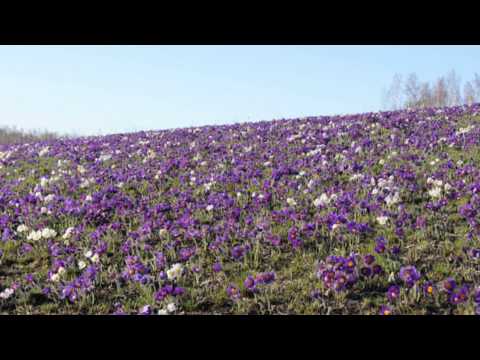

Watch this video on YouTube

